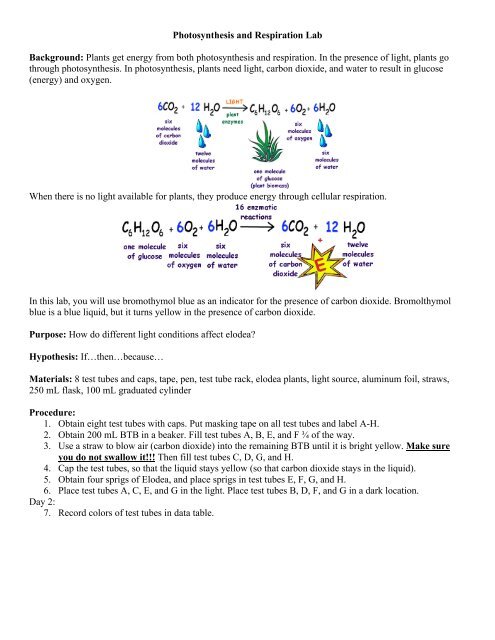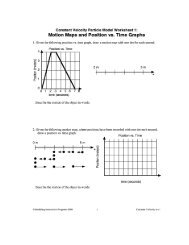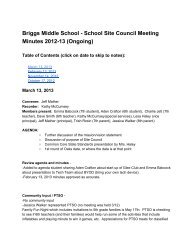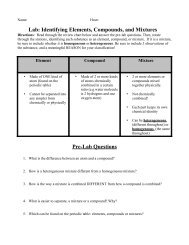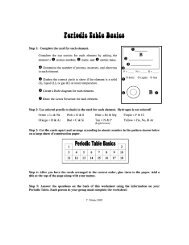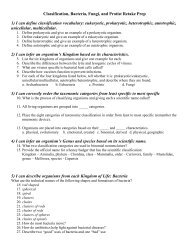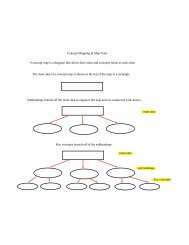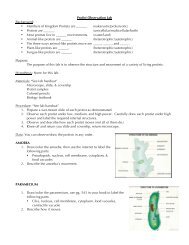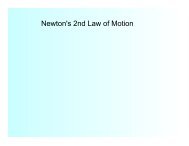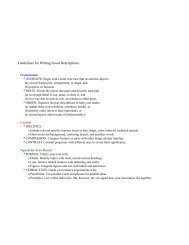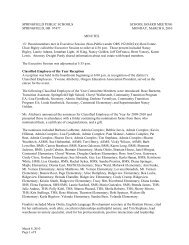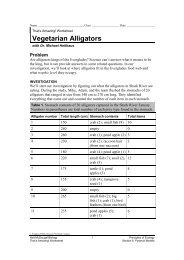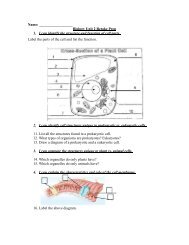Photosynthesis and Respiration Lab Background: Plants get energy ...
Photosynthesis and Respiration Lab Background: Plants get energy ...
Photosynthesis and Respiration Lab Background: Plants get energy ...
Create successful ePaper yourself
Turn your PDF publications into a flip-book with our unique Google optimized e-Paper software.
<strong>Photosynthesis</strong> <strong>and</strong> <strong>Respiration</strong> <strong>Lab</strong><br />
<strong>Background</strong>: <strong>Plants</strong> <strong>get</strong> <strong>energy</strong> from both photosynthesis <strong>and</strong> respiration. In the presence of light, plants go<br />
through photosynthesis. In photosynthesis, plants need light, carbon dioxide, <strong>and</strong> water to result in glucose<br />
(<strong>energy</strong>) <strong>and</strong> oxygen.<br />
When there is no light available for plants, they produce <strong>energy</strong> through cellular respiration.<br />
In this lab, you will use bromothymol blue as an indicator for the presence of carbon dioxide. Bromolthymol<br />
blue is a blue liquid, but it turns yellow in the presence of carbon dioxide.<br />
Purpose: How do different light conditions affect elodea?<br />
Hypothesis: If…then…because…<br />
Materials: 8 test tubes <strong>and</strong> caps, tape, pen, test tube rack, elodea plants, light source, aluminum foil, straws,<br />
250 mL flask, 100 mL graduated cylinder<br />
Procedure:<br />
1. Obtain eight test tubes with caps. Put masking tape on all test tubes <strong>and</strong> label A-H.<br />
2. Obtain 200 mL BTB in a beaker. Fill test tubes A, B, E, <strong>and</strong> F ¾ of the way.<br />
3. Use a straw to blow air (carbon dioxide) into the remaining BTB until it is bright yellow. Make sure<br />
you do not swallow it!!! Then fill test tubes C, D, G, <strong>and</strong> H.<br />
4. Cap the test tubes, so that the liquid stays yellow (so that carbon dioxide stays in the liquid).<br />
5. Obtain four sprigs of Elodea, <strong>and</strong> place sprigs in test tubes E, F, G, <strong>and</strong> H.<br />
6. Place test tubes A, C, E, <strong>and</strong> G in the light. Place test tubes B, D, F, <strong>and</strong> G in a dark location.<br />
Day 2:<br />
7. Record colors of test tubes in data table.
Data:<br />
Test Tube A B C D E F G H<br />
Light or light dark light dark light dark light Dark<br />
Dark<br />
Plant no plant no plant no plant no plant Elodea Elodea Elodea Elodea<br />
Carbon<br />
dioxide<br />
No CO 2<br />
added<br />
No CO 2<br />
added<br />
CO 2<br />
added<br />
CO 2<br />
added<br />
No CO 2<br />
added<br />
No CO 2<br />
added<br />
CO 2<br />
added<br />
CO 2<br />
added<br />
Color of<br />
test tube:<br />
Day 1<br />
Color of<br />
test tube:<br />
Day 2<br />
Analysis:<br />
1. What was the purpose of using bromothymol blue?<br />
2. Is bromothymol blue affected by light? How do you know? (Reference test tubes A-D)<br />
3. Compare test tubes B <strong>and</strong> F. What can you infer?<br />
4. Compare test tubes G <strong>and</strong> H.<br />
5. Compare test tubes G <strong>and</strong> C.<br />
6. Comparing tubes E <strong>and</strong> F, what happens to the CO 2 concentration? How does this connect to<br />
photosynthesis/respiration?<br />
Conclusion:<br />
• Restate the purpose<br />
• Summarize procedure<br />
• Explain results (connect to hypothesis)<br />
o What does this lab tell you about photosynthesis/respiration of plants?<br />
• Errors/modifications (you CANNOT say none)


